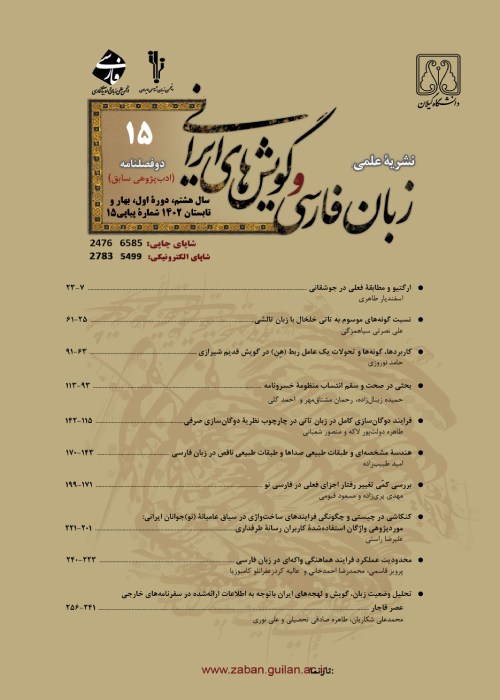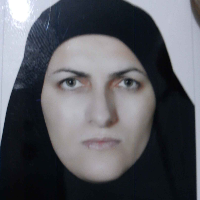Tracing of 35 Quatrains Attributed to Rumi in the Manuscripts and the Printed Versions of the Sanai's Divan and Older Texts
One of the poets whose quatrains can be traced in various forms among the quatrains of Rumi's Divan-e Kabir is Sana'i. After reviewing "Nozha Al-Majalis" and several valid manuscripts from Sanai's Divan, the number of common and similar quatrains to Sanai's Divan corrected by Modarres Razavi and Rumi's Divan-e Kabir corrected by Forouzanfar increased from 26 quatrains to 35 quatrains. In order to perform an accurate attribution analysis in the field of common and similar quatrains of these two poets, the works of poetry and prose of other poets and writers before Rumi, in addition to the mentioned sources, were also investigated. Out of a total of 35 common and similar quatrains, 24 quatrains from the Divan-e Kabir definitely belong to Sanai, or are guaranteed and adapted from his quatrains. 8 quatrains are most likely from Sanai, and the other 3 quatrains have been attributed to other poets in addition to Sanai. Of the Sana'i quatrains, only four quatrains are mentioned in complete and unchanged form in the Divan-e Kabir. In other cases, the quatrains are accompanied by changes that vary from a change in a few words to a change in three lines.
One of the Rumi's most important works in Persian literature is his quatrains. In Badi-ol-Zaman Forouzanfar's edition of Rumi's Divan, 1983 quatrains are attributed to him. In this work, traces of several quatrains can be found that belong to Sufi and non-Sufi poets before Rumi.One of the poets whose quatrains can be traced in various forms among the quatrains of Rumi's Divan-e Kabiris Sana'i. Rumi's poetic thought and style of expression, in his quatrains, like his other poems, has been influenced by Sanai's poetic thought and style of expression. The important point about the common quatrains of the Sanai's Divan and Rumi's Divan-e Kabir is that Rumi is not only the narrator of the Sanai's quatrains, in the form of direct and unchangeable quotations, but in most cases these quatrains in the Divan-e Kabirare accompanied by changes.
Several researchers such as Franklin D. Lewis, Badi-ol-Zaman Forouzanfar, Mohammad Amin Riahi, and also the prominent researcher of Persian quatrains, Sayyid Ali Mirafzali, have mentioned the existence of quatrains from other earlier poets among the quatrains of the Rumi's Divan-e Kabir. However, the only research that has been written in this field is an article entitled "Recognition of the source of 38 quatrains attributed to Rumi in literary and historical texts." In this research, in most cases, the quatrains have been investigated which are mentioned in earlier prose texts from previous poets. However, studying the common quatrains of Rumi's Divan-e Kabir cannot be performed in such a generalized study. Conducting more specialized research, the subject can be studied better and more accurately so that more new results can be achieved. In this study, by examining the Sanai's quatrains and comparing it with Rumi's quatrains, in addition to examining other earlier works, it has been tried to investigate the traces of the Sanai's quatrains in the Divan-e Kabir more carefully.
The most famous correction of the Sanai's Divan is the correction of the Modarres Razavi, however, none of the editions of the Sanai's Divan incompass all his quatrains. Therefore, in this article, we have also referred to the authentic manuscripts of Sanai's Divan. We argue that through finding all the common and similar quatrains of Sanai and Rumi, an accurate analysis in attributing the common quatrains according to the date of writing of this manuscripts can be achieved. Of course, in order to search for Sanai's quatrains among Rumi's quatrains, we did not just suffice to the Sanai's printed divan and the manuscripts of his divan, Because many wandering quatrains have been repeated many times in the Divans of early Poets that, in most cases, the poet of these quatrains cannot be determined with certainty, so in addition to examining the printed Divan and the most important manuscripts of the Sanai's Divan, other works of earlier poets and writers, Rumi was also examined in order to obtain more accurate results.
The study of the common quatrains of Divan-e Kabirand the Sanai's quatrains shows that Rumi, with his own style, often uttered the Sanai's quatrains with changes, so that 35 common and similar quatrains of these two poets can be divided into five following categories: 1. Four quatrains of the Divan-e Kabir in all four lines are completely similar to the Sanai's quatrains. 2. Sixteen quatrains from the Divan-e Kabir, while being similar to the Sanai's quatrains in all four lines, show some differences. 3. Four quatrains of the common quatrains of the Divan-e Kabir and Sanai's quatrains are similar in three lines. 4. Seven quatrains of the Divan-e Kabir are similar to the quatrains of the Sanai's Divan in only two lines. 5. Four quatrains of the Divan-e Kabir are similar to the quatrains of the Sanai's Divan in only one line.
After examining the quatrains of the "Nozhat Al-Majalis" collection and four manuscripts of Sanai's Divan, another 9 quatrains were added to the common and similar quatrains of Rumi's Divan-e Kabir and Sanai's printed Divan, and based on this, the number of common and similar quatrains of the two poets reached 35 quatrains. According to the present study, 24 quatrains from the Divan-e Kabir, based on two ancient manuscripts from the Sanai's Divan, as well as the collection of quatrains, "Nozhat Al-Majalis" and certain earlier prose texts, are definitely from Sanai, or have been guaranteed and adapted from his quatrains. The 8 common quatrains are most likely to belong to Sanai, based on the recent manuscripts of the Sanai's Divan and some stylistic features. The other three common quatrains are probably by Sanai, or another poet. In other words, these quatrains, in addition to Sanai, are also attributed to one or more other early poets.
- حق عضویت دریافتی صرف حمایت از نشریات عضو و نگهداری، تکمیل و توسعه مگیران میشود.
- پرداخت حق اشتراک و دانلود مقالات اجازه بازنشر آن در سایر رسانههای چاپی و دیجیتال را به کاربر نمیدهد.



